NEW YORK, United States — Monica Zwirner and Lucy Wallace Eustice,
the founders of MZ Wallace, were in their offices on Crosby Street in SoHo
recently. On the table in front of them lay fabric swatches and samples for an
upcoming collection. But the pair had turned their attention to a lookbook they
had produced over a decade ago.
اضافة اعلان
“I’m
scared to look,” Zwirner, 60, said. “This is so old”.
Wallace Eustice, 57, opened to a photograph of a shoulder bag.
“That’s good,” she said cautiously. She turned the page to look
at another picture of a purse. “And that’s … fine.”
“That’s not bad,” Zwirner admitted. She quickly flipped through
the rest and seemed relieved. “This actually feels good, to revisit something
you made so long ago and realize it still looks OK.”
MZ Wallace — the moniker is a combination of Zwirner’s initials
and Wallace Eustice’s maiden name — is a 22-year-old handbag and accessories
line that makes utilitarian, no-nonsense shoulder bags, totes, duffels,
backpacks, and other carryalls out of sustainable nylon fabrics.
The brand is not a household name. It does not possess a bold,
easily identifiable logo or color scheme like Chanel’s interlocking C’s or the
Gucci stripe. It does not advertise in fashion magazines. It has avoided famous
endorsements and flashy marketing campaigns.
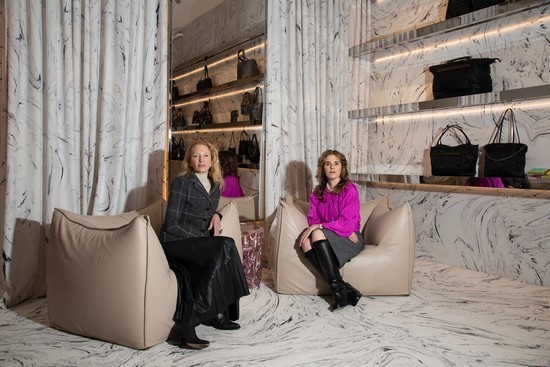
But it has nonetheless achieved a cult status among stylish
urbanites and a long list of celebrities that includes Jane Fonda, Jennifer
Garner, Anne Hathaway, Blake Lively, Sienna Miller, Julianne Moore,
LupitaNyong’o, Sarah Jessica Parker, Reese Witherspoon, and Renée Zellweger.
In August MZ Wallace opened a flagship store just across from
the offices on Crosby Street, designed by Charlap Hyman &Herrero, an
architecture and design firm. The space is blanketed with carpets, curtains,
and wallpaper decorated in an oversize trompe l’oeil marble print, inspired by
GioPonti’s marbled rubber floors in the Pirelli Tower in Milan. Its
southernmost wall is hung with artwork by Wolfgang Tillmans and Christopher
Williams. Metallic pedestals by artist Shun Kinoshita dot the display floor
alongside beige Mario Bellini chairs.
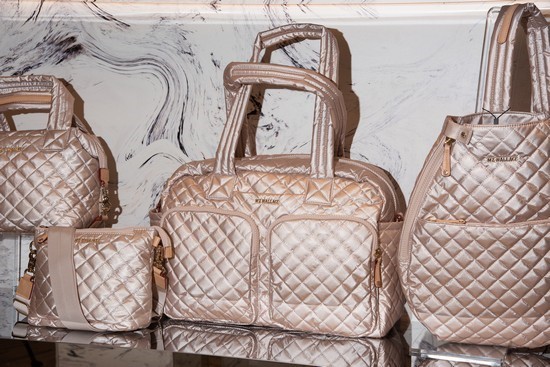
A second store in Chicago — where the brand has a similarly
strong customer base — opened at the same time.
Call it a high-low vibe. The brand owes its longevity and
success to its clever ability to marry practical design with luxury details. MZ
Wallace’s most popular style of fabric, a quilted puff nylon, serves as a
discreet brand emblem, as does a small diamond made of Italian leather sewn on
each product’s bottom gusset.
The proportions of each bag are intuitively functional: A large,
roomy tote slides perfectly on top of a carry-on suitcase; a slender cross-body
bag can comfortably fit your wallet, passport, keys, and phone. Certain
features reveal a thoughtful functionalism, such as the clips on an 18-pocket
backpack that allow it to fasten to a stroller.
Their bags also come with Italian leather trimmings and silver
hardware. Some are decorated with a bit of playful fringe, a fashionable chain,
or pretty leather-wrapped straps. And while black is an ever-popular customer color
choice, each season a new collection arrives in a variety of bright, bold hues
and patterns — a peony pink here, a muted sapphire blue there — all at
relatively reasonable prices.
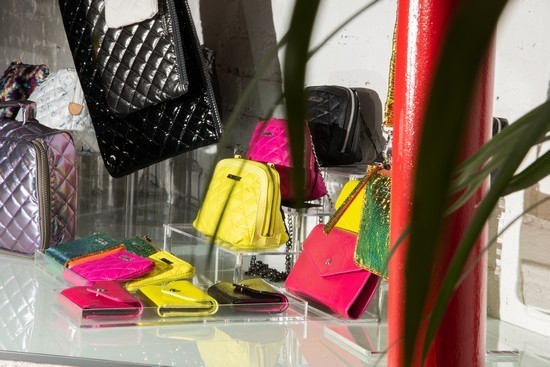
While not inexpensive, a weekend duffel bag, for example,
retails for $295; a shoulder bag for $185. (By comparison, a designer handbag
today can start at around $1,500.)
“Not that we have anything against expensive bags,” Wallace
Eustice said. “MZ Wallace is either your first bag or your second bag. Some
women like to have a more traditional designer bag and just use us as their
traveling tote or weekend bag.”
“We wanted to create bags that help you be — it sounds a bit
cheesy — a better you,” Zwirner added. “The bag’s not wearing you. And it can
help you get through your day, whatever kind of day you’re having and whatever
type of person you are.”
“I remember coming to the conclusion that they were, in a way,
the American answer to Longchamp,” said Adam Charlap Hyman, 32, co-founder of
Charlap Hyman &Herrero. “They were rendering something that feels elegant
in a material that is very practical. They’re not trying to be something
they’re not.”
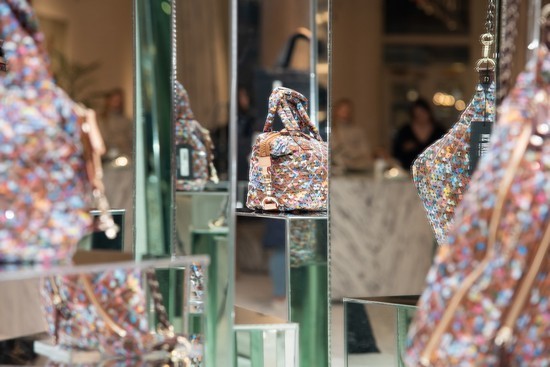
Zwirner began contemplating starting a handbag company when she
was a young mother in the late ’90s. As a former fashion stylist for Barbara
Dente and an interior designer for Selldorf Architects, she loved Prada’s nylon
bags but found them too expensive. Kate Spade had launched her line of popular
nylon box bags in 1993, but Zwirner found its aesthetic too girly, and more
traditional brands like LeSportSac and Hervé Chapelier had been around since the
’70s, leaving room for innovation.
“I remember thinking that there wasn’t a great American nylon
handbag company that was focused on style and design in a way that appealed to
me,” Zwirner said. “But I also knew I couldn’t do it alone. I had three small
children, and building something by myself just wasn’t possible.”
When Zwirner ran into Wallace Eustice, a friend, at New York’s
Union Square farmers market in the spring of 1999 — she with her youngest in a
stroller, Wallace Eustice with her newborn in a carrier — Zwirner asked if she
was interested in discussing an idea.
Wallace Eustice — a former accessories director who had worked
at Mirabella, Harper’s Bazaar and Elle — immediately liked the concept. But,
she added, they would need a store. She had gotten her start in retail with
shoe designer Manolo Blahnik and had witnessed firsthand how much of its success
had depended on a brick-and-mortar presence. With a store, they could have
relationships with their customers, which would be crucial in knowing what to
sell. They wouldn’t be beholden to the whims of a department store.
“It was direct-to-consumer before there was DTC,” Wallace
Eustice said, referring to today’s online practice of selling to the customer
without a middleman.
MZ Wallace debuted in May 2000 on Crosby Street, just a block
north of the current flagship. They sourced their nylon from Brookwood, a
textile company known for making high-tech military and medical fabrics. To
achieve their coveted quilted effect, they ran bolts of nylon through mattress
quilting machines in Brooklyn, which they then delivered to Manhattan’s garment
district to be manufactured.
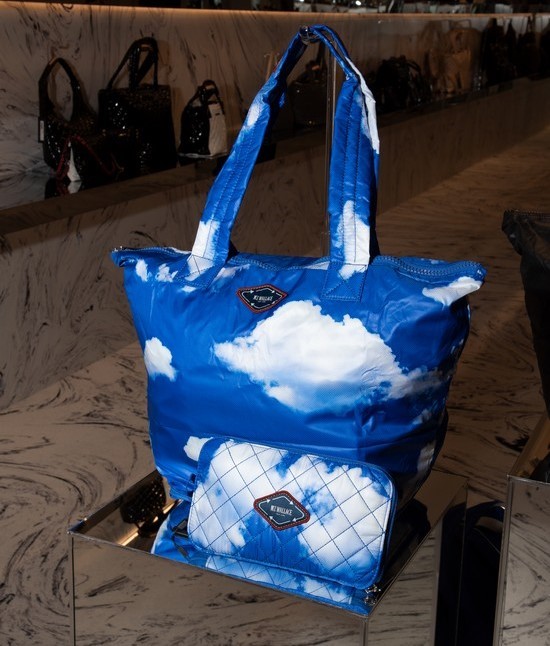
Initially, they offered a tote, a satchel, and a shoulder bag.
Word of mouth quickly generated interest, as did press from Wallace Eustice’s
friends and colleagues at various fashion magazines. But their bags were also,
Zwirner said, popular with a “a local customer — downtown moms who heard about
us, playground discoveries.”
Soon they had gained an avid following with Japanese customers.
“At the time, we were bigger in Japan than here,” Wallace Eustice said.
“By the way, they really only sold three bags,” said fashion
designer Isaac Mizrahi, 61, who was an early customer. “I promise you that. You
couldn’t get more. There were three styles. That was it. Bye-bye! And they were
great and everybody wanted them and they couldn’t keep up with it.”
As Wallace Eustice predicted, early buyers at department stores
didn’t understand the brand. They were told to change and raise their prices.
But the two stuck to their vision.
As MZ Wallace grew, so did its sense of purpose. Zwirner is
married to a German art dealer and gallerist, David Zwirner, and in 2011, she
and Wallace Eustice launched a special-edition bag, designed by artist Raymond
Pettibon, to raise money for Artists for Haiti, a nonprofit organization
founded by David Zwirner and actor Ben Stiller. Since then, they have produced
special-edition bags with organizations and artists such as Kerry James
Marshall, Njideka Akunyili Crosby and Glenn Ligon, with 100 percent of the
proceeds donated to a chosen nonprofit organization.
“I love to carry my Glenn Ligon bag because it often prompts
conversations about what’s most important to me, which is art and artists,”
said Thelma Golden, 57, director of the Studio Museum in Harlem, for which MZ
Wallace raised close to $100,000 with Ligon in 2014 for its art education
programs. “It gives me the chance to be the museum curator I am.”
“To me, the bag is the canvas,” said artist Nick Cave, 64, who
most recently designed a colorful MZ Wallace tote where all proceeds went to
support educational programs at the Museum of Contemporary Art Chicago and Facility
Foundation. “It’s this extension of an art practice. And I love the idea that
it is out in the world, being seen and being recognized.”
Today, MZ Wallace employs 40 people and offers over 400 styles.
Much of its manufacturing is now done in China and Vietnam. Sixty percent of
sales are from their website, which launched in 2004. Zwirner and Wallace
Eustice said that in the past three years the brand has grown by 20 percent
and, excluding the year they opened, they have seen year-over-year growth.
The business partners have been approached on several occasions
about selling their company, which is still privately held. They are open to
the idea. But they also like where they are. The two have lunch every day at
the office. They remain close friends.
“We have a laugh,” Wallace Eustice said. “You have to have fun
along the way. Otherwise, what’s the point?”
Read more Fashion
Jordan News








